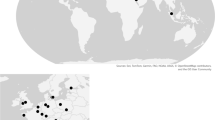Abstract
Two methodologies were developed to predict adsorption equilibria of a binary system when one of the components is described by the dual-process Langmuir (DPL) model and the other component is described by either the single process Langmuir (SPL) or linear isotherm (LI) model. Energetic site matching with the DPL–SPL model considered perfect positive (PP), perfect negative (PN) and unselective (US) correlations, and that with the DPL–LI model considered PP and PN correlations. A consistent set of single and binary isotherms for O2 and N2 on 5A zeolite were used to successfully demonstrate these concepts. For the DPL–SPL binary system, PP meant O2 adsorbed only on the N2 low energy site, PN meant O2 adsorbed only on the N2 high energy site, and US meant O2 adsorbed on both sites with the ratio of its saturation capacity on each site the same as that for N2. For this case, the PP model predicted the binary data well and correctly predicted that O2 only adsorbed on the low energy site of N2; the PN model predicted the data poorly and US was close but not as good as PP. The binary predictions from the DPL–SPL model that require only single component information to obtain the single component DPL and SPL parameters were nearly as good as those obtained from a non-predictive formulation similar to the US correlation but that utilized all the single and binary data to obtain the single component DPL and SPL parameters. For the DPL–LI binary system, with O2 having an affinity for only one site, PN meant O2 interacted solely with the high energy site of N2 and PP meant O2 interacted solely with the low energy site of N2; and because O2 exhibited a linear isotherm (i.e., the Henry’s law constants from the SPL parameters), it did not affect the adsorption of N2 on its sites, but N2 did affect the adsorption of O2 on its sites. For this case, the PP model predicted the binary data well and correctly predicted that O2 did not affect the adsorption of N2, but that N2 did affect the adsorption of O2 on the low energy site of N2; the PN model predicted the data poorly.






Similar content being viewed by others
Abbreviations
- A:
-
Component A
- b j,i :
-
Affinity parameter of component i (= A or B) on Site j (= 1 or 2), kPa−1
- \( b_{{o_{j,i} }} \) :
-
Pre-exponential factor of component i (= A or B) on Site j (= 1 or 2), kPa−1
- B:
-
Component B
- E j,i :
-
Adsorption energy of component i (= A or B) on Site j (= 1 or 2), kJ mol−1
- \( K_{j,i} \) :
-
Henry’s law constant for component i (= A or B) on Site j (= 1 or 2), mol kg−1 kPa−1
- \( K_{{o_{j,i} }} \) :
-
Henry’s law constant pre-exponential factor of component i (= A or B) on Site j (= 1 or 2), kPa−1
- n :
-
Total amount adsorbed from single gas or gas mixture, mol kg−1
- n i :
-
Amount adsorbed of component i (= A or B) from single gas, mol kg−1
- n i,m :
-
Amount adsorbed of component i (= A or B) from gas mixture, mol kg−1
- \( n_{j,i}^{s} \) :
-
Saturation capacity of component i (= A or B) on Site j (= 1 or 2), mol kg−1
- \( n_{j}^{s} \) :
-
Saturation capacity on Site j (= 1 or 2), mol kg−1
- N :
-
Number of data points
- P :
-
Absolute pressure, kPa
- R :
-
Universal gas constant, kJ mol−1 K−1
- T :
-
Absolute temperature, K
- x i :
-
Adsorbed phase mole fraction of component i (= A or B)
- y i :
-
Gas phase mole fraction of component i (= A or B)
- z e :
-
Experimental quantity in Eq. 24
- z p :
-
Predicted quantity in Eq. 24
References
Awadallah-F, A., Al-Muhtaseb, S.A.: Carbon dioxide sequestration and methane removal from exhaust gases using resorcinol–formaldehyde activated carbon xerogel. Adsorption 19, 967–977 (2013)
Awadallah-F, A., Al-Muhtaseb, S.A., Jeong, H.-K.: Selective adsorption of carbon dioxide, methane and nitrogen using resorcinol-formaldehyde-xerogel activated carbon. Adsorption 23, 933–944 (2017)
Brandani, F., Ruthven, D.M.: Measurement of adsorption equilibria by the zero length column (ZLC) technique. Part 2: binary systems. Ind. Eng. Chem. Res. 42, 1462–1469 (2003)
Brunchi, C.C., Englebienne, P., Kramer, H.J., Schnell, S.K., Vlugt, T.J.: Evaluating adsorbed-phase activity coefficient models using a 2D-lattice model. Mol. Simul. 41, 1234–1244 (2014)
Caldwell, S.J., Al-Duri, B., Sun, N., Sun, C.-G., Snape, C.E., Li, K., Wood, J.: Carbon dioxide separation from nitrogen/hydrogen mixtures over activated carbon beads: adsorption isotherms and breakthrough studies. Energy Fuels 29, 3796–3807 (2015)
Do, D.D., Do, H.D.: On the azeotropic behavior of adsorption systems. Adsorption 5, 319–329 (1999)
Dreisbach, F., Staudt, R., Keller, J.U.: High pressure adsorption data of methane, nitrogen, carbon dioxide and their binary and ternary mixtures on activated carbon. Adsorption 5, 215–227 (1999)
Erden, L., Erden, H.: On the use of multi-site Langmuir model for prediction of non-ideal gas mixture adsorption isotherms. Usak Univ. J. Mater. Sci. 6, 7–14 (2017)
Erden, H., Ebner, A.D., Ritter, J.A.: Development of a pressure swing adsorption cycle for producing high purity CO2 from dilute feed streams. Part I: feasibility study. Ind. Eng. Chem. Res. 57, 8011–8022 (2018a)
Erden, L., Ebner, A.D., Ritter, J.A.: Separation of landfill gas CH4 from N2 using pressure vacuum swing adsorption cycles with heavy reflux. Energy Fuels 32, 3488–3498 (2018b)
Farmahini, A.H., Krishnamurthy, S., Friedrich, D., Brandani, S., Sarkisov, L.: From crystal to adsorption column: challenges in multiscale computational screening of materials for adsorption separation processes. Ind. Eng. Chem. Res. 57, 15491–15511 (2018)
García, S., Pis, J.J., Rubiera, F., Pevida, C.: Predicting mixed-gas adsorption equilibria on activated carbon for precombustion CO2 capture. Langmuir 29, 6042–6052 (2013)
Gholami, M., Talaie, M.R.: Investigation of simplifying assumptions in mathematical modeling of natural gas dehydration using adsorption process and introduction of a new accurate LDF model. Ind. Eng. Chem. Res. 49, 838–846 (2010)
Gholami, M., Talaie, M.R., Roodpeyma, S.: Mathematical modeling of gas dehydration using adsorption process. Chem. Eng. Sci. 65, 5942–5949 (2010)
Goel, C., Bhunia, H., Bajpai, P.K.: Prediction of binary gas adsorption of CO2/N2 and thermodynamic studies on nitrogen enriched nanostructured carbon adsorbents. J. Chem. Eng. Data 62, 214–225 (2016)
Goel, C., Tiwari, D., Bhunia, H., Bajpai, P.K.: Pure and binary gas adsorption equilibrium for CO2-N2 on oxygen enriched nanostructured carbon adsorbents. Energy Fuels 31, 13991–13998 (2017)
Jahromi, P.E., Fatemi, S., Vatani, A.: Effective design of a vacuum pressure swing adsorption process to recover dilute helium from a natural gas source in a methane-rich mixture with nitrogen. Ind. Eng. Chem. Res. 57, 12895–12908 (2018a)
Jahromi, P.E., Fatemi, S., Vatani, A., Ritter, J.A., Ebner, A.D.: Purification of helium from a cryogenic natural gas nitrogen rejection unit by pressure swing adsorption. Sep. Purif. Technol. 193, 91–102 (2018b)
Khalighi, M., Farooq, S., Karimi, I.A.: Nonisothermal pore diffusion model for a kinetically controlled pressure swing adsorption process. Ind. Eng. Chem. Res. 51, 10659–10670 (2012)
Khurana, M., Farooq, S.: Adsorbent screening for postcombustion CO2 capture: a method relating equilibrium isotherm characteristics to an optimum vacuum swing adsorption process performance. Ind. Eng. Chem. Res. 55, 2447–2460 (2016)
Ko, D., Siriwardane, R., Biegler, L.T.: Optimization of pressure swing adsorption and fractionated vacuum pressure swing adsorption processes for CO2 capture. Ind. Eng. Chem. Res. 44, 8084–8094 (2005)
Krishnamurthy, S., Rao, V.R., Guntuka, S., Sharratt, P., Haghpanah, R., Rajendran, A., Amanullah, M., Karimi, I.A., Farooq, S.: CO2 Capture from dry flue gas by vacuum swing adsorption: a pilot plant study. AIChE J. 60, 1830–1842 (2014a)
Krishnamurthy, S., Haghpanah, R., Rajendran, A., Farooq, S.: Simulation and optimization of a dual-adsorbent, two-bed vacuum swing adsorption process for CO2 capture from wet flue gas. Ind. Eng. Chem. Res. 53, 14462–14473 (2014b)
Langmuir, I.: The adsorption of gases on plane surfaces of glass, mica and platinum. J. Am. Chem. Soc. 40, 1361–1403 (1918)
Liu, Y., Holland, C.E., Ritter, J.A.: Pressure swing adsorption-solvent vapor recovery-III: comparison of simulation with experiment for the butane-activated carbon system. Sep. Sci. Technol. 34, 1545–1576 (1999)
Liu, Y., Ritter, J.A., Kaul, B.K.: Pressure swing adsorption cycles for improved solvent vapor enrichment. AIChE J. 46, 540–551 (2000a)
Liu, Y., Ritter, J.A., Kaul, B.K.: Simulation of gasoline vapor recovery by pressure swing adsorption. Sep. Purif. Technol. 20, 111–127 (2000b)
Mathias, P.M., Kumar, R., Moyer, J.D., Schork, J.J.M., Srinivasan, S.R., Auvil, S.R., Talu, O.: Correlation of multicomponent gas adsorption by the dual-site langmuir model. Application of nitrogen/oxygen adsorption on 5A-zeolite. Ind. Eng. Chem. Res. 35, 2477–2483 (1996)
Mohammadi, N., Hossain, M.I., Ebner, A.D., Ritter, J.A.: New pressure swing adsorption cycle schedules for producing high-purity oxygen using carbon molecular sieve. Ind. Eng. Chem. Res. 55, 10758–10770 (2016)
Myers, A.L.: Activity coefficients of mixtures adsorbed on heterogeneous surfaces. AIChE J. 29, 691–693 (1983)
Nikolaidis, G.N., Kikkinides, E.S., Georgiadis, M.C.: A model-based approach for the evaluation of new zeolite 13X-based adsorbents for the efficient post-combustion CO2 capture using P/VSA processes. Chem. Eng. Res. Des. 131, 362–374 (2018)
Pahinkar, D.G., Garimella, S.: Experimental and computational investigation of gas separation in adsorbent-coated microchannels. Chem. Eng. Sci. 173, 588–606 (2017)
Pahinkar, D.G., Garimella, S., Robbins, T.R.: Feasibility of using adsorbent-coated microchannels for pressure swing adsorption: parametric studies on depressurization. Ind. Eng. Chem. Res. 54, 10103–10114 (2015)
Pahinkar, D.G., Garimella, S., Robbins, T.R.: Feasibility of temperature swing adsorption in adsorbent-coated microchannels for natural gas purification. Ind. Eng. Chem. Res. 56, 5403–5416 (2017)
Perez, L.E., Avila, A.M., Sawada, J.A., Rajendran, A., Kuznicki, S.M.: Process optimization-based adsorbent selection for ethane recovery from residue gas. Sep. Purif. Technol. 168, 19–31 (2016)
Purdue, M.J.: Explicit flue gas adsorption isotherm model for zeolite 13X incorporating enhancement of nitrogen loading by adsorbed carbon dioxide and multi-site affinity shielding of coadsorbate dependent upon water vapor content. J. Phys. Chem. C 122, 11832–11847 (2018)
Rezaei, F., Mosca, A., Webley, P., Hedlund, J., Xiao, P.: Comparison of traditional and structured adsorbents for CO2 separation by vacuum-swing adsorption. Ind. Eng. Chem. Res. 49, 4832–4841 (2010)
Ritter, J.A., Bhadra, S.J., Ebner, A.D.: On the use of the dual process langmuir model for correlating unary and predicitng mixed gas adsorption equilibria. Langmuir 27, 4700–4712 (2011)
Rocha, L.A., Andreassen, K.A., Grande, C.A.: Separation of CO2/CH4 using carbon molecular sieve (CMS) at low and high pressure. Chem. Eng. Sci. 164, 148–157 (2017)
Swisher, J.A., Lin, L.-C., Kim, J., Smit, B.: Evaluating mixture adsorption models using molecular simulation. AIChE J. 59, 3054–3064 (2013)
Talu, O., Li, J., Kumar, R., Mathias, P.M., Moyer Jr., J.D., Schork, J.M.: Measurement and correlation of oxygen/nitrogen/5a-zeolite adsorption equilibria for air separation. Gas Sep. Purif. 10, 149–159 (1996)
Tien, C.: Adsorption Calculation and Modeling. Butterworth-Heinemann, Boston (1994)
Wilkins, N.S., Rajendran, A.: Measurement of competitive CO2 and N2 adsorption on zeolite 13X for post-combustion CO2 capture. Adsorption 25, 115–133 (2019)
Xiao, P., Zhang, J., Webley, P., Li, G., Singh, R., Todd, R.: Capture of CO2 from flue gas streams with zeolite 13X by vacuum-pressure swing adsorption. Adsorption 14, 575–582 (2008)
Yang, R.T.: Adsorbents: Fundamentals and Applications. Wiley, Hoboken (2003)
Funding
The authors gratefully acknowledge continued financial support provided over many years by both the NASA Marshall Space Flight Center and the Separations Research Program at UT-Austin.
Author information
Authors and Affiliations
Corresponding author
Ethics declarations
Conflict of interest
The authors declare they have no conflicts of interest.
Additional information
Publisher's Note
Springer Nature remains neutral with regard to jurisdictional claims in published maps and institutional affiliations.
Rights and permissions
About this article
Cite this article
Ritter, J.A., Bumiller, K.C., Tynan, K.J. et al. On the use of the dual process Langmuir model for binary gas mixture components that exhibit single process or linear isotherms. Adsorption 25, 1511–1523 (2019). https://doi.org/10.1007/s10450-019-00159-6
Received:
Revised:
Accepted:
Published:
Issue Date:
DOI: https://doi.org/10.1007/s10450-019-00159-6




